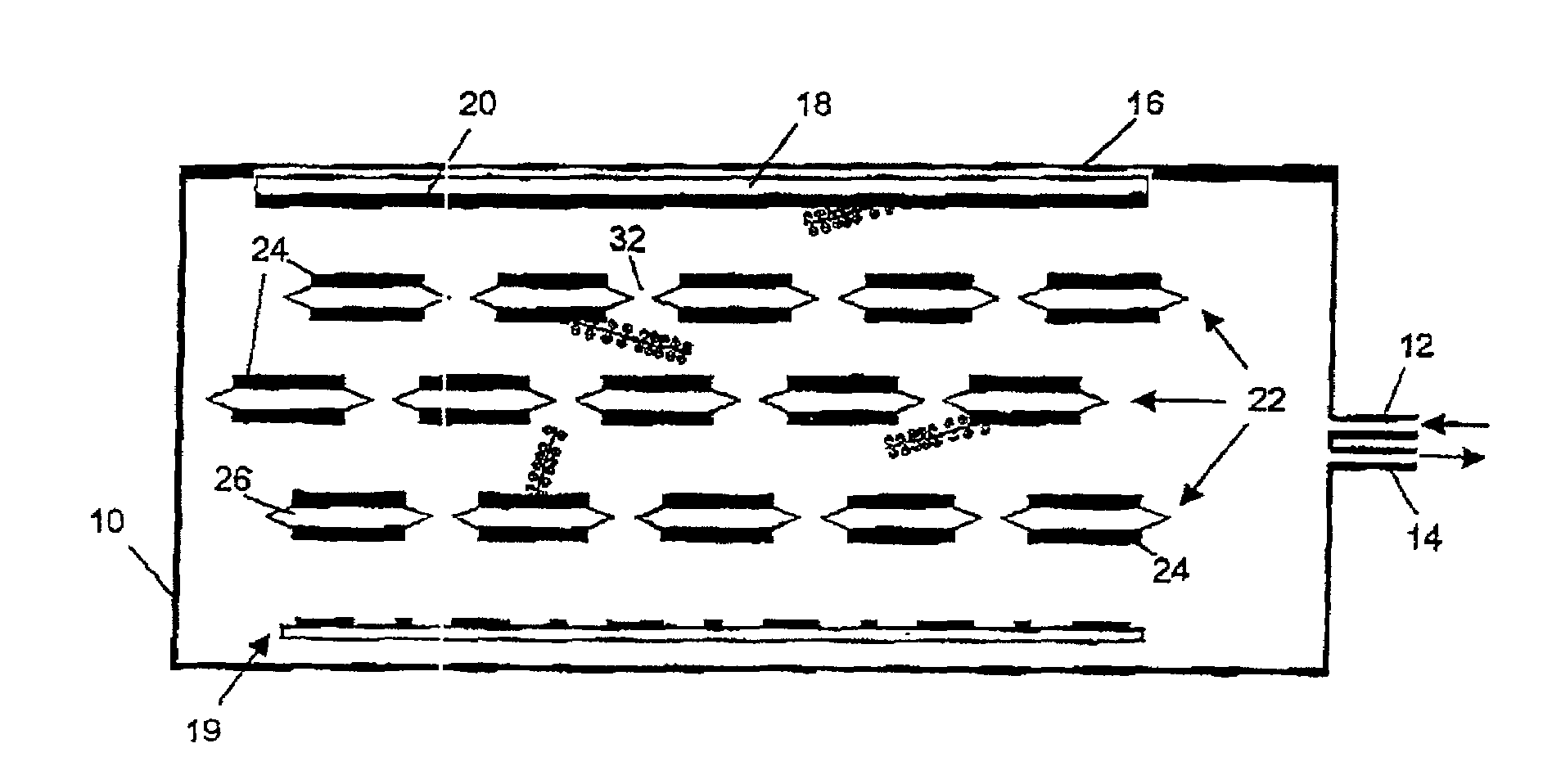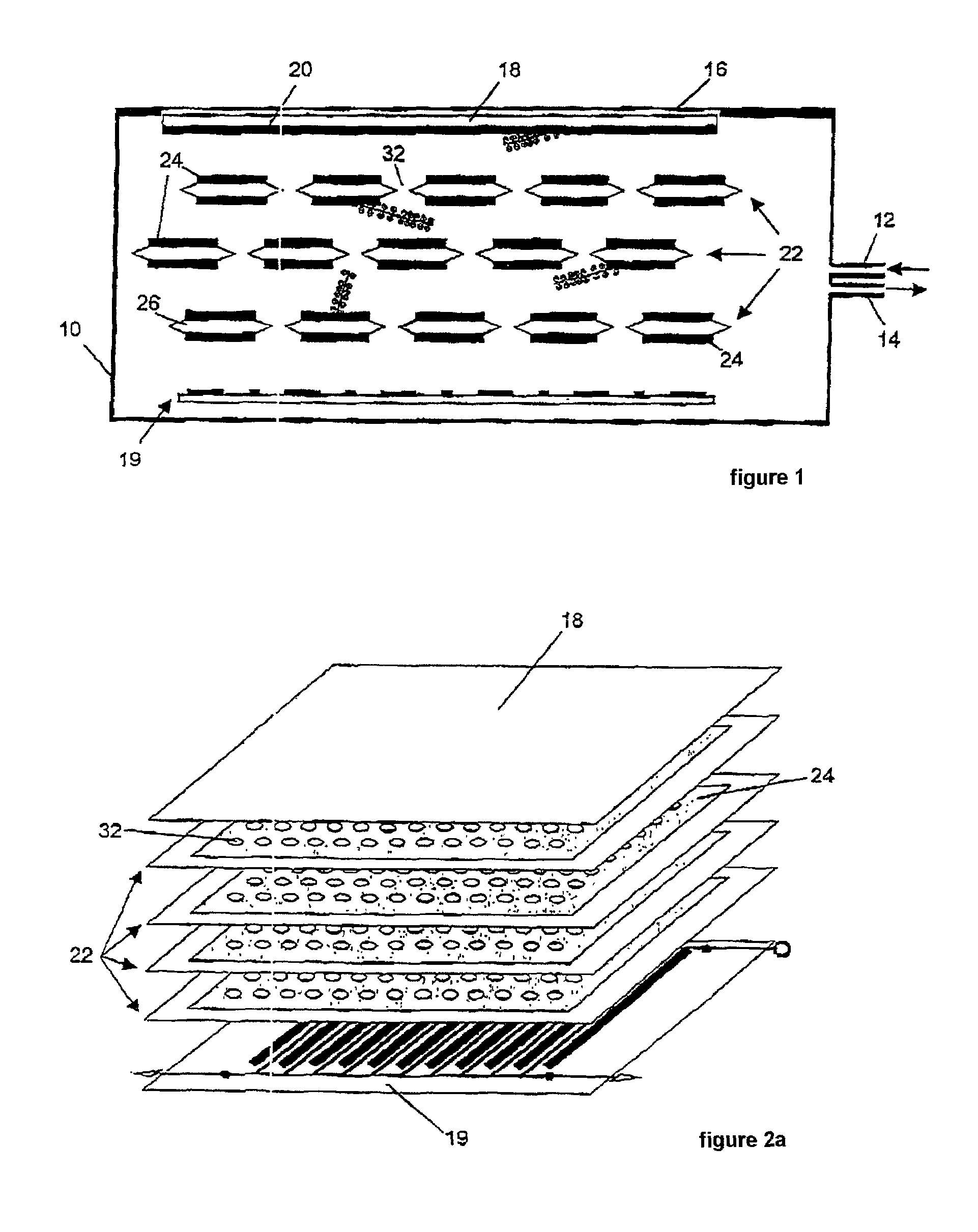[0014]According to a particularly preferred embodiment, the detector has a multiplicity of, preferably 2 to 20, most preferably 10, converter devices arranged in
cascade form (in series). In particular, the converter devices may in each case be arranged at a distance from one another in the form of a stack in the detector housing, so that the counting gas is situated between the converter devices. The result is a large
active surface area for the interaction with the converter device which is required for detection of the neutral particles. Because of the charge-transparent nature of the converter devices, the charged particles which are generated by the conversion products and the detection of which allows the neutral particles to be detected can be moved through the
cascade of converter devices to the readout device by means of the
drift field. The use of converter devices arranged in
cascade form in the detector according to the invention accordingly enables the interaction surface area available for the electrically neutral particles to be increased enormously and therefore enables the detection sensitivity to be increased considerably.
[0015]Preferably, a region of the converter device which is active in the conversion of the electrically neutral particles is of large-area, in particular planar, design and is preferably arranged substantially perpendicularly in the drift field. As well as planar surfaces, large-area structures which are curved as desired are also conceivable, for example cylindrical structures. This large-area or film-like structure of the converter device allows the surface to volume ratio of the converter device to be improved further. Although the (
solid) converter material in the entire volume is typically sensitive to the neutral particles which are to be detected, the conversion products often only have a relatively
restricted range in the converter material and therefore can only escape from this material if they lie sufficiently close to its surface; this means that to achieve a high detection sensitivity, it is advantageous, for a given converter volume and
mass, to have as large a converter surface area as possible available for detection. Particularly efficient and rapid diversion of the charged electrical particles generated to the readout device is achieved if the converter device is arranged substantially perpendicularly in the drift field. Accordingly, the mean field direction of the drift field is advantageously substantially parallel to the surface normal of the converter device, which is of large-area design. An inclined arrangement of the converter device is also possible, provided that the plane of the large-area converter device does not run parallel to the drift field.
[0020]According to a further preferred embodiment, the first and second conductive
layers of the converter device are electrically connected to one another via a device for generating a converter field. The device for generating a converter field makes it possible to generate an electrical drift field which in particular may act in addition to the drift field generated by the device for generating a drift field. This ensures that the electrically charged particles can be efficiently passed through the converter device.
[0023]According to the invention, a converter device for a detector for detecting electrically neutral particles, in particular neutrons, comprises a first conductive layer and a second conductive layer which are electrically insulated from one another by an insulator layer arranged between them, and at least one (
solid) converter layer, which is preferably arranged on the first conductive layer and / or on the second conductive layer, the converter device having a multiplicity of passages, which are preferably arranged in the form of a matrix, for electrically charged particles. A converter layer of this type can be used in combination with a conventional
gas detector for simple and
highly sensitive detection of neutral particles, in particular neutrons. For this purpose, the converter device is introduced into the drift field of the
gas detector. It is particularly preferable if a “stack” of converter devices in a cascade arrangement is used rather than an individual converter device, since this allows the detection sensitivity to be increased enormously.
[0028]The charge-transparent design of the converter device enables the charged particles to be passed through the converter device(s) without losing their position information. It therefore follows from the charge transparency that the location where the charged particles are generated in the counting gas is reproduced or transferred without
distortion through the converter device(s) to the readout device, which is preferably position-sensitive.
 Login to View More
Login to View More  Login to View More
Login to View More 


